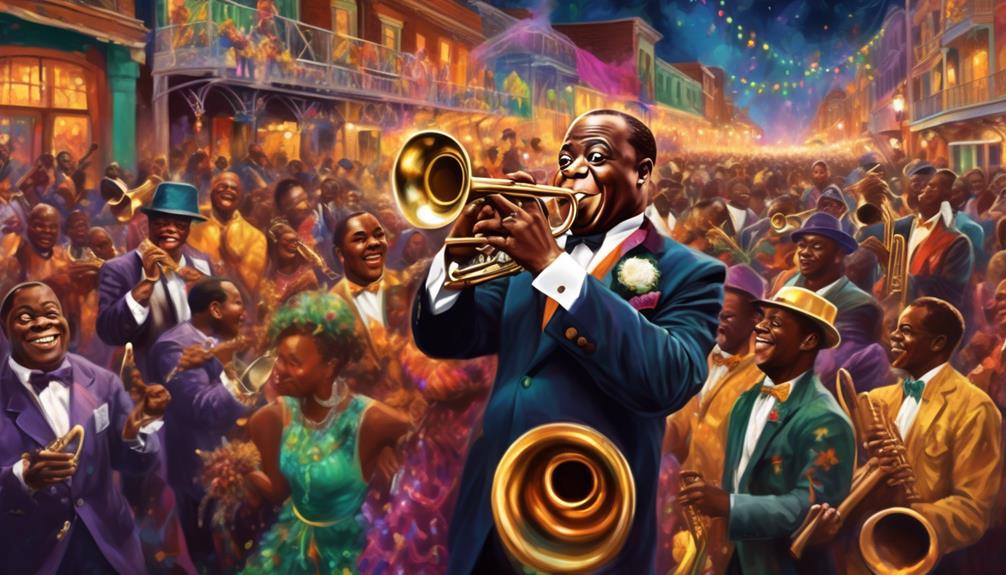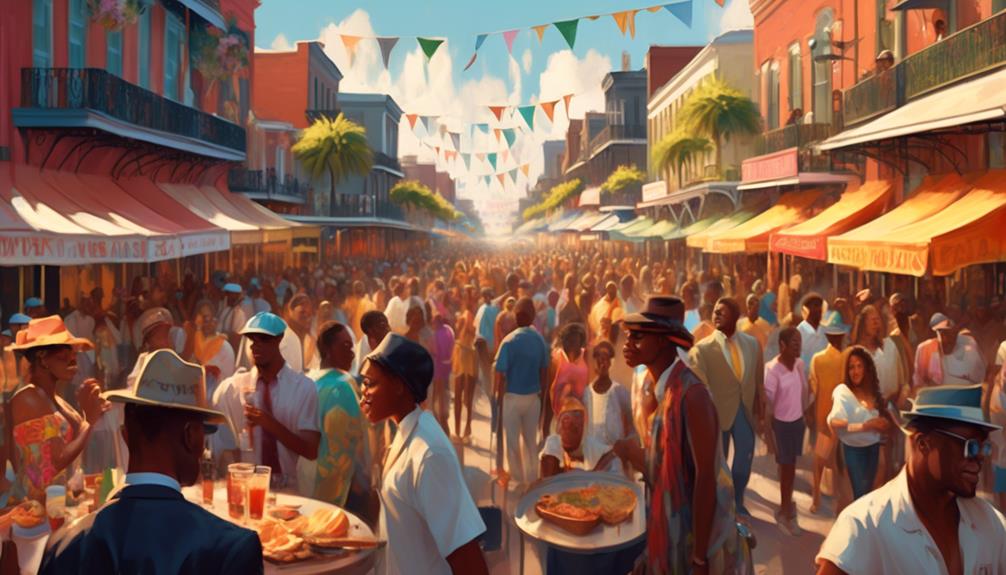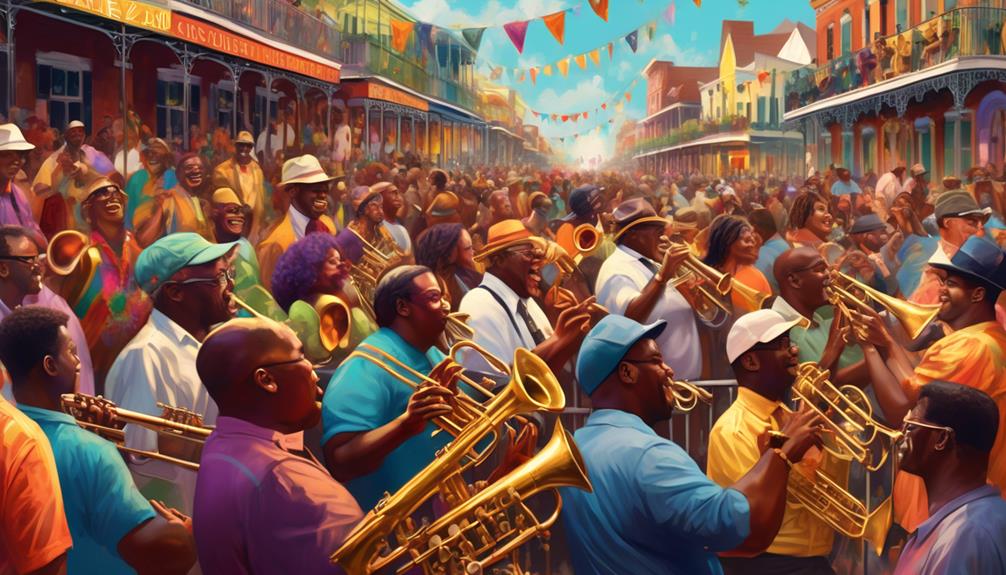
Can you feel the pulsating rhythm of New Orleans Jazz coursing through history's veins? You're about to embark on a journey through the five most significant chapters in the illustrious history of the New Orleans Jazz and Heritage Festival.
From its birth in 1970 with legends like Mahalia Jackson and Duke Ellington gracing the stage, to the memorable 1972 move to the Fair Grounds featuring Thelonious Monk and Nina Simone, each chapter is a testament to the rich legacy of this iconic event.
As we explore further, the echoes of Stevie Wonder in '73, Gladys Knight and the Pips in '74, and the unforgettable performances from B.B. King and McCoy Tyner in '75, will undoubtedly resonate within your soul.
So, are you ready to immerse yourself in these captivating tales that shaped the festival's vibrant tapestry?
Key Takeaways
- The New Orleans Jazz and Heritage Festival has a rich history and has evolved to become a globally recognized celebration of music and culture.
- Iconic performances by Duke Ellington, Mahalia Jackson, Stevie Wonder, and B.B. King have played a significant role in shaping the festival's legacy.
- The festival has had a profound impact on the city's economy, sparking a tourism boom and supporting local businesses.
- The Jazz Fest Foundation plays a crucial role in promoting and preserving Louisiana's music, culture, and heritage through the festival and various community programs.
The Festival's Inception and Evolution
When the New Orleans Jazz and Heritage Festival first kicked off in April 1970, with performances by Mahalia Jackson and Duke Ellington, no one knew it would evolve into the major cultural celebration it's today. The first Jazz Fest took place at Congo Square and drew in 350 people, a modest crowd compared to the hundreds of thousands that attend today.
In 1972, the Jazz and Heritage Fest moved to the Fair Grounds Race Course in Gentilly, marking a significant expansion. The festival showcased more genres, blending jazz with blues, gospel, and other styles, and embracing the rich Crescent City culture.
The annual Jazz Fest continued to grow, and by 1973, it was celebrating Louisiana's diverse cuisine alongside performances by stars like Stevie Wonder and B.B. King. This fusion of music and food became a hallmark of the New Orleans Jazz Fests.
The Jazz Fest expanded again in 1975, introducing multiple stages and evening concerts. Today, after 142 festivals, it's recognized globally as a significant celebration of music and culture. You've seen the New Orleans Jazz and Heritage Festival transform from its humble beginnings to a major cultural phenomenon.
Iconic Performances Over the Years
Throughout the years, you've seen an array of iconic performances at the New Orleans Jazz and Heritage Festival. From Mahalia Jackson's inaugural performance in Congo Square back in 1970 to the unforgettable sets by stars like Stevie Wonder, B.B. King, and the Staple Singers in 1973, these are moments that have defined the history of the festival.
Let's take a brief journey:
- 1970:
- Duke Ellington closing the annual festival
- Pete Fountain treating fans to a steamship concert
- Mahalia Jackson belting out tunes in Congo Square
- 1973:
- Stevie Wonder's electrifying set
- The soulful Staple Singers
- B.B. King, the King of Blues, performing
The Heritage Fair has always been a highlight of the festival, featuring the Preservation Hall Jazz Band, a New Orleans institution that's been around since the Newport Jazz Festival days. These iconic performances echo the vibrant history of the New Orleans Jazz and Heritage Festival, painting a vivid picture of the city's rich cultural tapestry.
Every year, the festival continues to deliver unforgettable moments, making it one of the most anticipated events in the music calendar.
Impact on New Orleans' Economy

While you've been captivated by the iconic performances, it's also crucial to recognize the profound impact the festival has had on New Orleans' economy.
The annual Jazz and Heritage Festival, part of Crescent City's vibrant music and culture scene, has been an economic linchpin, contributing significantly to the area's financial health.
The Heritage Fest in April celebrates a rich array of genres, including jazz, gospel, and more. This local music extravaganza immediately sparked a tourism boom in the 1970s and 1980s, infusing new life into the city's economy.
The Orleans Jazz and Heritage Festival's success has been consistent, annually attracting audiences that exceed the total population of Orleans Parish.
This massive influx of visitors not only boosts the city's economy through festival ticket sales, but also through increased patronage of local businesses.
The impact of the festival extends beyond the confines of the event itself, fueling the local economy and supporting the vibrant and unique culture that makes New Orleans so special.
Therefore, the Jazz and Heritage Festival isn't just a celebration of music and culture, but a vital component of New Orleans' economic vitality.
The Role of Jazz Fest Foundation
Established in 1970, the Jazz Fest Foundation has been at the heart of the festival's success, working tirelessly to promote and preserve Louisiana's rich music, culture, and heritage. Founded by George Wein, inspired by the success of the Newport Folk Festival, the foundation was given life by Quint Davis and Allison Miner. The Heritage Foundation, as it's often called, plays a pivotal role in the Jazz Fest history, making the event more than just a fair; it's a celebration of New Orleans' vibrant local music scene and diverse culture.
The Foundation's role is multifaceted, which includes:
- Overseeing the New Orleans Jazz & Heritage Festival, ensuring it remains a platform for local artists to shine.
- Managing WWOZ 90.7 FM, the local radio station that brings the sounds of the festival to those who can't be there in person.
- Running the Jazz & Heritage Foundation Archive, preserving the history and legacy of Jazz Fest for future generations.
The Foundation's work goes beyond the festival, engaging with the local community through various programs. The Jazz Fest Foundation's role is instrumental in shaping the festival's legacy, contributing to its recognition as one of the world's greatest cultural celebrations.
The Signature Jazz Fest Experience

Building on the vibrant local music scene fostered by the Jazz Fest Foundation, the Signature Jazz Fest Experience immerses you in a rich tapestry of iconic performances and unique musical moments. The New Orleans Jazz and Heritage Festival transforms the Crescent City into a music extravaganza, with a lineup of legends spanning jazz, blues, R&B, and more. You'll witness performances by iconic artists like Mahalia Jackson, Duke Ellington, and B.B. King, alongside local favorites like Fats Domino and Pete Fountain.
The Signature Jazz Fest Experience offers more than music. Imagine yourself strolling through the festival grounds, taking in the rich Louisiana Heritage on the Acura Stage, total attendance swelling with the energy of the city. You'll find a plethora of food and craft vendors showcasing the best of New Orleans cuisine and artisanal talent. Don't forget to catch a glimpse of the vibrant Mardi Gras Indians, a sight as mesmerizing as the music itself.
From steamship concerts on the river to impromptu clarinet shows, the Signature Jazz Fest Experience is a unique blend of music, culture, and local flavor that defines the New Orleans Jazz and Heritage Festival.
Frequently Asked Questions
What Was the Largest Crowd at the Jazz Fest?
You're asking about the largest crowd at a jazz fest. Well, the New Orleans Jazz and Heritage Festival hit a record in 1975 with an attendance of 80,000 people. It's one of the biggest music fests in the US.
What Is the Famous Jazz Festival in New Orleans?
Imagine you're in the heart of Louisiana, soaking up the vibrant culture. The famous jazz festival you're seeking is the New Orleans Jazz and Heritage Festival, a musical feast that's a must-visit for jazz enthusiasts.
Who Was the Most Successful and Famous New Orleans Jazz Musician?
You're asking about the most successful and famous New Orleans jazz musician. That's Louis Armstrong. His unique trumpet playing and vocals made him a jazz pioneer, influencing many musicians and leaving a lasting legacy.
What Is the Most Notable Feature in New Orleans Jazz?
You'd likely say the most notable feature of New Orleans jazz is its unique blend of styles. It's not just about the music, it's about the culture and community that's been built around it.
Conclusion
You've journeyed through the top chapters of New Orleans Jazz Fest history, witnessing iconic performances and the festival's profound impact on the local economy.
The Jazz Fest Foundation's pivotal role in the event's success can't be overlooked. It's mind-boggling to realize that this beloved event rakes in over $300 million annually. That's the power of music and tradition, right?
So here's to the boundless energy and soulful rhythm of the Jazz Fest Experience.
